Japan Toddlers Cram for Kindergarten
- Share via
TOKYO — With exam season starting, Rina Sassa has a lot to remember--apples are red, three comes after two, and always push in your chair when getting up from the table.
Rina, 3, is one of dozens of pint-sized students at Tomu Young Children’s School preparing for their first taste of Japan’s education rat race: private kindergarten and elementary school entrance tests.
“The basics are numbers and shapes and language skills,” said Mariko Kato, Rina’s teacher.
Entrance exams are a rite of passage in Japanese education, where students’ destinies often are determined by tests to enter high school and college and serious students attend after-hours “cram schools.”
But the mounting competition for top schools has pushed the cramming craze to new extremes--toddlers, some still in diapers.
Many schools now train infants starting at 6 months old to pass entrance exams for kindergarten and elementary schools run by private universities. Acceptance puts children on the elite fast-track to college.
It’s unclear how many cram schools there are for toddlers, but browsing through a school guide for the Tokyo area turns up dozens. Two major chains have 500,000 pre-schoolers enrolled throughout Japan, said Toshiyuki Shiomi, an education professor at Tokyo University.
Shiomi said he and other experts are worried youngsters are being pushed by parents to meet high expectations before they can handle it emotionally.
“To pressure kids who can’t even express themselves yet to do something they don’t want to do will end up warping Japanese society,” he said.
At Tomu’s branch in the Ikebukuro district in central Tokyo, about 40 pre-schoolers are enrolled in courses aimed at kindergarten entrance tests. The monthly tuition is 15,000 yen, about $135.
*
Some mothers said they were encouraged to send their toddlers to classes by scientific studies--highlighted in Tomu’s advertising--that almost all the human brain’s capacity is determined in the first few years of life.
In Kato’s class, Rina and her three classmates worked hard one recent afternoon coloring in paper apples and acorns, counting, identifying animals and practicing their manners.
In the hourlong class, which students take once a week, it was clear there was a right and a wrong way to do things--just as there will be on the exams these children will eventually take.
“Have you ever seen a pink apple?” Kato asked Rina, who wanted to color her paper apple a little differently from the other students.
The toddler protested, insisting that her grandmother had recently brought her some pink apples. But she eventually gave in, following Kato’s instructions to color over her unorthodox pink apple with a red crayon.
More to Read
Sign up for Essential California
The most important California stories and recommendations in your inbox every morning.
You may occasionally receive promotional content from the Los Angeles Times.













